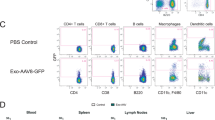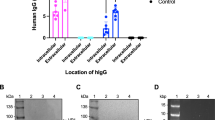Abstract
Lentiviral-based vectors hold great promise as gene delivery vehicles for the treatment of a wide variety of diseases. We have previously reported the development of a nonprimate lentiviral vector system based on the equine infectious anaemia virus (EIAV), which is able to efficiently transduce dividing and nondividing cells both in vitro and in vivo. Here, we report on the application of EIAV vectors for the systemic delivery of an antibody fusion protein designed for the treatment of cancer. The therapeutic potential of a single chain antibody against the tumour-associated antigen, 5T4, fused to immune enhancer moieties has been demonstrated in vitro and here we evaluate the genetic delivery of a 5T4 scFv fused to B7.1 (scFvB7) using an EIAV vector. The kinetics and concentration of protein produced following both intravenous (i.v.) and intramuscular (i.m.) administration was determined in immune competent adult mice. In addition, the immune response to the EIAV vector and the transgene were determined. Here, we show that a single injection of EIAV expressing scFv-B7 can give rise to concentrations of protein in the range of 1–5 μg/ml that persist in the sera for more than 50 days. After a second injection, concentrations of scFv-B7.1 rose as high as 20 μg/ml and levels greater than 2 μg/ml were present in the sera of all mice injected i.v. after 210 days despite the detection of antibodies against both the transgene and viral envelope for the duration of this study. These results demonstrate the potential of EIAV as a gene therapy vector for long-term production of therapeutic recombinant proteins.
This is a preview of subscription content, access via your institution
Access options
Subscribe to this journal
Receive 12 print issues and online access
$259.00 per year
only $21.58 per issue
Buy this article
- Purchase on Springer Link
- Instant access to full article PDF
Prices may be subject to local taxes which are calculated during checkout









Similar content being viewed by others
References
Bieker R, Kessler T, Berdel WE, Mesters RM . Rituximab in combination with platinum-containing chemotherapy in patients with relapsed or primary refractory diffuse large B-cell lymphoma. Oncol Rep 2003; 10: 1915–1917.
Martinelli G et al. Chlorambucil in combination with induction and maintenance rituximab is feasible and active in indolent non-Hodgkin's lymphoma. Br J Haematol 2003; 123: 271–277.
McCafferty J, Hoogenboom H, Chiswell D (eds). Antibody Engineering. Oxford University Press: Oxford, 1996, (Hames B, ed. A Practical Approach, Vol 169).
Yokota T, Milenic DE, Whitlow M, Schlom J . Rapid tumor penetration of a single-chain Fv and comparison with other immunoglobulin forms. Cancer Res 1992; 52: 3402–3408.
Hornick JL et al. Chimeric CLL-1 antibody fusion proteins containing granulocyte-macrophage colony-stimulating factor or interleukin-2 with specificity for B-cell malignancies exhibit enhanced effector functions while retaining tumor targeting properties. Blood 1997; 89: 4437–4447.
Cooke SP et al. In vivo tumor delivery of a recombinant single chain Fv::tumor necrosis factor-alpha fusion [correction of factor: a fusion] protein. Bioconjug Chem 2002; 13: 7–15.
Whittington HA, Ashworth LJ, Hawkins RE . Recombinant adenoviral delivery for in vivo expression of scFv antibody fusion proteins. Gene Therapy 1998; 5: 770–777.
Arafat WO et al. Effective single chain antibody (scFv) concentrations in vivo via adenoviral vector mediated expression of secretory scFv. Gene Therapy 2002; 9: 256–262.
Dai Y et al. Cellular and humoral immune responses to adenoviral vectors containing factor IX gene: tolerization of factor IX and vector antigens allows for long-term expression. Proc Natl Acad Sci USA 1995; 92: 1401–1405.
Chirmule N et al. Immune responses to adenovirus and adeno-associated virus in humans. Gene Therapy 1999; 6: 1574–1583.
Konishi H et al. Targeting strategy for gene delivery to carcinoembryonic antigen-producing cancer cells by retrovirus displaying a single-chain variable fragment antibody. Hum Gene Ther 1998; 9: 235–248.
Coffin JM, Hughes SH, Varmus HE eds. Retroviruses. Cold Spring Harbor Laboratory Press: Cold Spring Harbor, NY, 1997.
Naldini L et al. In vivo gene delivery and stable transduction of nondividing cells by a lentiviral vector. Science 1996; 272: 263–267.
Kim VN, Mitrophanous K, Kingsman SM, Kingsman AJ . Minimal requirement for a lentivirus vector based on human immunodeficiency virus type 1. J Virol 1998; 72: 811–816.
Olsen JC . EIAV, CAEV and other lentivirus vector systems. Somat Cell Mol Genet 2001; 26: 131–145.
Quinonez R, Sutton RE . Lentiviral vectors for gene delivery into cells. DNA Cell Biol 2002; 21: 937–951.
Olsen JC . Gene transfer vectors derived from equine infectious anemia virus. Gene Therapy 1998; 5: 1481–1487.
Mitrophanous K et al. Stable gene transfer to the nervous system using a non-primate lentiviral vector. Gene Therapy 1999; 6: 1808–1818.
Azzouz M et al. Multicistronic lentiviral vector-mediated striatal gene transfer of aromatic L-amino acid decarboxylase, tyrosine hydroxylase, and GTP cyclohydrolase I induces sustained transgene expression, dopamine production, and functional improvement in a rat model of Parkinson's disease. J Neurosci 2002; 22: 10302–10312.
Bienemann AS et al. Long-term replacement of a mutated nonfunctional CNS gene: reversal of hypothalamic diabetes insipidus using an EIAV-based lentiviral vector expressing arginine vasopressin. Mol Ther 2003; 7: 588–596.
Southall PJ et al. Immunohistological distribution of 5T4 antigen in normal and malignant tissues. Br J Cancer 1990; 61: 89–95.
Starzynska T, Rahi V, Stern PL . The expression of 5T4 antigen in colorectal and gastric carcinoma. Br J Cancer 1992; 66: 867–869.
Myers KA et al. Isolation of a cDNA encoding 5T4 oncofetal trophoblast glycoprotein. An antigen associated with metastasis contains leucine-rich repeats. J Biol Chem 1994; 269: 9319–9324.
Myers KA et al. Targeting immune effector molecules to human tumor cells through genetic delivery of 5T4-specific scFv fusion proteins. Cancer Gene Ther 2002; 9: 884–896.
Mazarakis ND et al. Rabies virus glycoprotein pseudotyping of lentiviral vectors enables retrograde axonal transport and access to the nervous system after peripheral delivery. Hum Mol Genet 2001; 10: 2109–2121.
Brattain MG et al. Establishment of mouse colonic carcinoma cell lines with different metastatic properties. Cancer Res 1980; 40: 2142–2146.
Hole N, Stern PL . A 72 kDa trophoblast glycoprotein defined by a monoclonal antibody. Br J Cancer 1988; 57: 239–246.
Adams GP et al. Increased affinity leads to improved selective tumor delivery of single-chain Fv antibodies. Cancer Res 1998; 58: 485–490.
Coll JM . The glycoprotein G of rhabdoviruses. Arch Virol 1995; 140: 827–851.
Mulryan K et al. Attenuated recombinant vaccinia virus expressing oncofetal antigen (tumor-associated antigen) 5T4 induces active therapy of established tumors. Mol Cancer Ther 2002; 1: 1129–1137.
Busch DH, Pilip IM, Vijh S, Pamer EG . Coordinate regulation of complex T cell populations responding to bacterial infection. Immunity 1998; 8: 353–362.
Martin-Rendon E et al. New methods to titrate EIAV-based lentiviral vectors. Mol Ther 2002; 5: 566–570.
Follenzi A et al. Efficient gene delivery and targeted expression to hepatocytes in vivo by improved lentiviral vectors. Hum Gene Ther 2002; 13: 243–260.
Pan D et al. Biodistribution and toxicity studies of VSVG-pseudotyped lentiviral vector after intravenous administration in mice with the observation of in vivo transduction of bone marrow. Mol Ther 2002; 6: 19–29.
Tsui LV et al. Production of human clotting Factor IX without toxicity in mice after vascular delivery of a lentiviral vector. Nat Biotechnol 2002; 20: 53–57.
Follenzi A et al. Targeting lentiviral vector expression to hepatocytes limits transgene-specific immune response and establishes long-term expression of human antihemophilic factor IX in mice. Blood 2003; 30: 30.
Freer G et al. Vesicular stomatitis virus Indiana glycoprotein as a T-cell-dependent and -independent antigen. J Virol 1994; 68: 3650–3655.
Burkhart C et al. Characterization of T-helper epitopes of the glycoprotein of vesicular stomatitis virus. J Virol 1994; 68: 1573–1580.
VandenDriessche T et al. Lentiviral vectors containing the human immunodeficiency virus type-1 central polypurine tract can efficiently transduce nondividing hepatocytes and antigen-presenting cells in vivo. Blood 2002; 100: 813–822.
Baekelandt V et al. Optimized lentiviral vector production and purification procedure prevents immune response after transduction of mouse brain. Gene Therapy 2003; 10: 1933–1940.
Yamada K, McCarty DM, Madden VJ, Walsh CE . Lentivirus vector purification using anion exchange HPLC leads to improved gene transfer. Biotechniques 2003; 34: 1074–1078, 1080.
Acknowledgements
We gratefully acknowledge MG Ryan, N Drury, A Warner and P Henbest for technical assistance.
Author information
Authors and Affiliations
Rights and permissions
About this article
Cite this article
Lamikanra, A., Myers, K., Ferris, N. et al. In vivo evaluation of an EIAV vector for the systemic genetic delivery of therapeutic antibodies. Gene Ther 12, 988–998 (2005). https://doi.org/10.1038/sj.gt.3302484
Received:
Accepted:
Published:
Issue Date:
DOI: https://doi.org/10.1038/sj.gt.3302484
Keywords
This article is cited by
-
Enhanced pseudotyping efficiency of HIV-1 lentiviral vectors by a rabies/vesicular stomatitis virus chimeric envelope glycoprotein
Gene Therapy (2012)
-
Lentiviral gene transfer to reduce atherosclerosis progression by long-term CC-chemokine inhibition
Gene Therapy (2009)
-
Genetic Vaccination: One-Shot Shopping for Immediate and Sustained Protection
Molecular Therapy (2008)
-
Gene delivery by lentivirus vectors
Molecular Biotechnology (2007)



